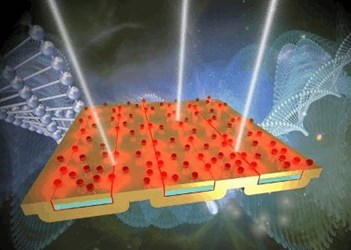Light-Trapping Sensor Improves Spectroscopy By Leaps And Bounds
By Jof Enriquez,
Follow me on Twitter @jofenriq

A new light-trapping sensor fabricated by engineers at the University at Buffalo has been demonstrated to be capable of up to 1,000 times greater resolution than existing spectroscopy devices that detect minute amounts of substances.
Fabricated using a method called atomic layer deposition, the optical device consists of an insulator sandwiched between two layers of metal, which have a gap between them of less than five nanometers (a strand of human hair is about 75,000 nanometers wide). The nanogap allows up to 81 percent of light in the mid-infrared band of the electromagnetic spectrum to pass through, which is significantly greater than the roughly 3 percent that similar sensors allow.
"The strong localized field supported in these nanogap super absorbing metamaterial patterns can significantly enhance light–matter interaction at the nanoscale, which will enable the development of novel on-chip energy harvesting/conversion, and surface enhanced spectroscopy techniques for bio/chemical sensing," the scientists wrote in a study published in Advanced Optical Materials.
The new sensor acts a substrate for materials being analyzed, and can achieve 100 to 1,000 times greater resolution than other surface-enhanced infrared absorption (SEIRA) devices in current use.
"This new optical device has the potential to improve our abilities to detect all sorts of biological and chemical samples," says Qiaoqiang Gan, PhD, associate professor of electrical engineering in the School of Engineering and Applied Sciences at UB, and the study's lead author, in a news release.
Such a powerful sensor could be utilized in fields such as law enforcement, doping testing, and anti-terrorism to detect illicit drugs and bomb-making chemicals otherwise undetectable by conventional equipment. It also could be used to uncover fraudulent art work, as well as analyze tissues and biomolecules to monitor diseases, if combined with other spectroscopic techniques.
"By coating these structures with chemical/biological molecules, it is successfully demonstrated that the fingerprints of molecules in the mid-infrared absorption spectroscopy are enhanced significantly with the enhancement factor up to 106–107, representing a record for surface enhanced infrared absorption spectroscopy," wrote Gan and co-authors Dengxin Ji, Alec Cheney, Nan Zhang Haomin Song and Xie Zeng, PhD, along with researchers from Fudan University, Northeastern University, and the University of Wisconsin-Madison.
Due to the boost in sensitivity, this new device is considered comparable to surface-enhanced Raman spectroscopy or surface-enhanced Raman scattering (SERS), which measures scattered light to detect single molecules. The researchers are working to merge their surface-enhanced infrared absorption (SEIRA) spectroscopy technique with cutting-edge Raman scattering methods to achieve even greater resolution of trace materials.
